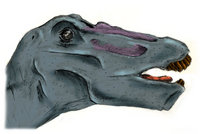Apatosaurus
Apatosaurus, often mistakenly refered to as Brontosaurus, is a genus of sauropod dinosaurs that lived about 140 million years ago, during the Jurassic period. They were some of the largest land animals that ever existed, about 4. more...
5 metres (15 feet) tall at the hips, with a length of up to 25m (80 feet) and a mass up to 35 metric tonnes (40 tons). However, the Argentinosaurus was even larger.
The cervical vertebra and the bones in the legs were bigger and heavier than that of Diplodocus, but they both had the long neck and tail. The skull was first identified in 1975, a century after it got its name. The Apatosaurus had a claw on its hand, but only the thumb. Scientists have a theory about the tail being lifted perhaps a meter above the ground. It would prevent the dinosaur from stomping on it, and put the tail out of reach of predators.
Environment
Early on, it was believed that Apatosaurus was too massive to support its own weight on dry land, so it was theorized that the sauropod must have lived partly submerged in water, perhaps in a swamp. Recent findings do not support this. In fact, like its relative Diplodocus, Apatosaurus was a grazing animal with a very long neck, and a long tail that served as a counterweight. Fossilized footprints indicate that it probably lived in herds. To aid in processing food, Apatosaurus may have swallowed gizzard stones (gastroliths) the same way many birds do today — its jaws alone were not sufficient to chew tough plant fibers.
The Apatosaurs perhaps lumbered along in flocks on riverbanks with trees, eating off the top leaves. Scientists believe that these sauropods could not raise their neck to an angle of 90 degrees, as doing so would slow blood flow to the brain excessively; blood starting at the body proper would take two or more minutes to reach the brain. Furthermore, studies of the structure of the neck vertebrae have revealed that the neck was not as flexible as previously thought. No one knows how Apatosaurs ate enough food to satisfy their enormous bodies. They probably ate constantly, pausing only to cool off, drink or to remove parasites. They must have slept standing upright. If attacked by a predator, it could defend itself by swinging its tail from side to side, or stomp at the meat-eater. Because of the Apatosaurs’ slow speed, they lived in herds, and they could "call" on each other, if one needed help.
Classification and history
In 1877, Othniel Charles Marsh published notes on his discovery of the Apatosaurus, and then in 1879 described another, more complete dinosaur — the Brontosaurus. In 1903, it was discovered that the apatosaur was in fact a juvenile brontosaur, and the name Apatosaurus, having been published first, was deemed to have priority as the official name; Brontosaurus was relegated to being a synonym. The name was not formally removed from the records of paleontology until 1974.
Fossils of this animal have been found in Nine Mile Quarry and Bone Cabin Quarry in Wyoming, and at sites in Colorado, Oklahoma, Utah, USA.
Species
- A. ajax is the type species of the genera, and was named by the paleontologist Othniel Charles Marsh in 1877 after Ajax, the hero from Greek mythology. It is the holotype for the genera, and two partial skeletons have been found including part of a skull.
- A. excelsus (originally Brontosaurus) was named by Marsh in 1879. It is known from six partial skeletons, including part of a skull, which have been found in the United States, in Oklahoma, Utah, and Wyoming.
- A. louisae was named by William Holland, in 1915. It is known from one partial skeleton, which was found in Colorado, in the United States.
Robert T. Bakker made A. yahnahpin the type species of a new genus, Eobrontosaurus in 1998, so it is now properly Eobrontosaurus yahnahpin. It was named by Filla, James and Redman in 1994. One partial skeleton has been found in Wyoming.
Read more at Wikipedia.org



